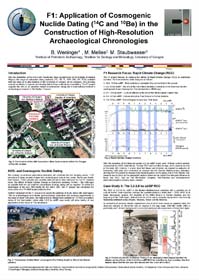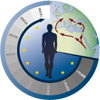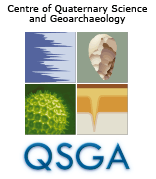Research Programme
Exact chronological data are essential to evaluate the timing, duration and rhythms of population dynamics and human migrations. They also form the basis to decipher dependencies of human development on climatic and environmental changes, by the identification of coincidences, leads or lacks to these potential natural forcing factors. Project F1 has two main components, each with focus on establishing highprecision chronologies based on radiometric dating methods. The first component involves archaeological and sedimentological case studies in the eastern transect of the CRC, employing 14C- and initial 10Be-exposure dating. The second component provides a Central Radiocarbon Service for the entire CRC.
Own fieldwork and excavations will be carried out in Bulgaria, Turkey, and Jordan. These studies focus on the effects of rapid climate change (RCC) on prehistoric societies during the following key time-windows for the Holocene:
- 10.2-10.0 ka cal BP: appearance of sedentary hunting/farming communities in SE-Anatolia,
- 8.6-8.0 ka cal BP: spread of early farming from Central Anatolia to Southeast-Europe,
- 6.4-6.0 ka cal BP: abrupt collapse (or slow decay?) of Copper Age cultures in Southeast-Europe,
- 4.2-4.0 ka cal BP: cultural disruption in Greece and West Anatolia, and
- 3.2-2.9 ka cal BP: end of the Mycenaean culture.
The project is strongly built on high-precision 14C-dating of samples supplied by a large number of archaeologists from carefully selected running excavations in the regions under study, as well as by our own, dedicated fieldwork. Besides, the method of in-situ produced 10Be-dating by AMS will be applied to rubble slides within an archaeological context. The service component for the CRC includes the processing of conventional 14C-dates with existing equipment for Low-Level ß-decay 14C-measurement, the construction and operation of a new 14C-AMS target preparation laboratory, and the 14C-dating of selfproduced targets with the new 6 MV Accelerator Mass Spectrometer (AMS) that has recently been appointed to the University of Cologne. In addition, the F1 project provides support for all CRC projects in all questions related to radiocarbon dating. This includes a Central Radiocarbon Service (administration, documentation, packaging, interlaboratory transfer, database management) of all samples that are to be dated by the 14C-method.
Aims
The major aims of the F1 project were (1) to develop and employ sample preparation procedures and vacuum systems required for 14C dating of different sample material (e.g. bones, carbonates, wood, sediment) with the new 6 MV Accelerator Mass Spectrometer (AMS) at the University of Cologne (CologneAMS), and (2) to study the impact of Rapid Climate Change (RCC) on prehistoric societies in the Glacial and Holocene periods.
Aim (1) was mainly pursued by Prof. Dr. Janet Rethemeyer, who joined the F1 team when she became appointed at the University of Cologne as Junior Professor (W1) in August 2009. The work of J. Rethemeyer was supported by the technical assistant (Svetlana Koenig), by scientific and student assistants employed by project F1, and, as announced in the F1 proposal, by another technical assistant (Ulrike Patt) provided by the Institute of Prehistoric Archeology of the University of Cologne. Further support of the analytical developments and the preparation of the large number of samples for CRC clusters A, B, C, and F was provided by members of J. Rethemeyer's working group, including a postdoctoral researcher (Dr. Reka Fülöp) appointed in October 2010 and an engineer (Bianca Stapper).
For aim (2), project F1 had scheduled archaeological and geomorphological fieldwork in (A) Jordan, in order to understand the causes of the deep Rubble Layers that cover a large number of major Pre-Pottery Neolithic B (PPNB) sites, and (B) in Northeast Bulgaria and on the western Turkish coast, to date the exact time of arrival of the earliest farming communities in relation to the 8.6-8.0 ka cal BP RCC interval.
Results
(1) CologneAMS: Development of 14C-Dating Facilities
The new AMS facility at the University of Cologne is based on a 6 MV Tandetron system from ´HighVoltage Engineering Europe´, funded by DFG in 2007 and installed at the Institute of Nuclear Physics by mid 2010 (Dewald et al., in press). The laboratory for the preparation of radiocarbon samples became integrated in the existing organic geochemistry laboratories at the Institute of Geology and Mineralogy, both run by J. Rethemeyer. This provides additional analytical possibilities such as chromatographic isolation of individual organic molecules for compoundspecific radiocarbon analysis.
Prior to the AMS installation in 2010, J. Rethemeyer and group members started to establish and test chemical sample preparation methods for different materials, including organic samples, carbonates and bones, with reference materials of the 5th radiocarbon ring trial (VIRI). Since the CologneAMS was not operational at this stage, these first tests were measured on the MICADAS AMS at the ETH Zürich, Switzerland. For sample graphitization - reduction of sample CO2 obtained by carbonate hydrolysis or organic sample combustion - an automated graphitization system (AGE) developed by the AMS group at ETH Zürich was purchased and set up at the University of Cologne. The AGE system consists of an elemental analyzer (VarioMicroCube, Elementar, Germany) for combustion and a computer-controlled vacuum system for graphitization. It is equipped with a zeolite trap for CO2 concentration and subsequent release into 7 reactors for CO2 reduction with hydrogen and iron powder as catalyst. The advantage of this system is the automation of the otherwise very time-consuming graphitization procedure in sealed quartz tubes and self-made vacuum manifolds (Rethemeyer et al. 2011), which also requires well-trained technical staff.
After installation of the AGE in July 2010, detailed tests were performed with different reference and standard materials. Tests of carbon yielded very promising blank values, obtained for normal but also for smaller sample sizes. For instance, for a sample size of about 200 μg C a still reasonable blank value of 0.52 pmC, equivalent to 43,400 ± 600 years BP, was obtained (Rethemeyer et al., in press). Since the combustion of carbonate samples, in contrast, gave no reliable results, the AGE system was advanced by the construction of a semi-automated hydrolysis device coupled with the graphitization system (Wacker et al. 2011). Thereby, carbonate hydrolysis is performed in a similar way as it is often done in stable isotope ratio mass spectrometry: CO2 is released with acid in a septum-sealed tube under helium atmosphere instead of acid decomposition in evacuated glass tubes and subsequent CO2 reduction to graphite in self-made reduction manifolds. The CO2 evolving is flushed in a helium flow by means of a double-walled needle mounted from the tubes to the zeolite trap of the AGE (Wacker et al., in press). These developments and subsequent detailed tests, which yielded extremely low blank values around 51,000 years BP, were performed in close collaboration with the AMS group at ETH Zürich.
Despite the delay of routine sample preparation, due to the need for preceding comprehensive tests of sample processing procedures and analytical developments, we were able to pretreat and date about 250 samples for CRC projects until October 2012. Further developments include the isolation and 14C dating of individual lipid biomarkers in organic matter with preparative gas chromatography (Rethemeyer et al., in press), which is currently applied in a pilot study for refining the sediment chronology of Lake Yoa (project A1).
For improvements in 14C data analyses, we have extended the CalPal 14C databases (Holocene: 18000 entries; Glacial: 8000 entries) in the course of F1 (work package headed by B. Weninger). Further, we have developed software for cartographic management of archaeological sites, and have implemented new dialogs for user-friendly (mouse/spreadsheet-touch) archaeological 14C-database
management. In addition, CalPal dialogs have been made available for convenient (automated: mouse-based screen-touch) age-age-synchronisation of climate records as well as for age-depth-modelling of terrestrial and marine records (e.g., Jöris et al., 2011).
Finally, we have shown in a theoretical paper (Weninger et al., 2011) that the method of Bayesian Sequencing - although widely applied in the construction of archaeological chronologies - will quite generally produce chronological results that have only spuriously enhanced dating precision. The underlying reason is that the presently applied Classical (i.e. non quantum-theoretical) Bayesian Theory does not allow for the non-commutative character of radiocarbon calibration. Critical comparisons of analytical results achieved by the classical and quantum-theoretical 14C-calibration procedures are published in Schmidt et al. (2012) and Benz et al. (in press).
(2) High-Resolution Archaeological Chronologies: Impact of Rapid Climate Change
The fieldwork undertaken in the F1 project (2009-2012) is summarized in Table 1. In each case the project aims were successfully completed. This includes the fieldwork, the post-excavation work (e.g. sample export), the laboratory processing of geomorphological and radiometric samples, as well as the publication of achieved results.

Fieldwork in Jordan and subsequent geomorphological analyses of studied trench sections at 'Ain Ghazal, Ba'ja and Basta have shown that rubble layers contain mainly building materials from deserted and collapsed PPNB-houses (Zielhofer et al., in press). As such, the objective of 10Be dating of rubble slides became futile. Further settlement and chronology studies undertaken in the frame of the PhD study by L. Clare have shown that these settlements were depopulated in the centuries attributed to RCC. As it appears from complementary social-vulnerability studies, the impact of the 8.6-8.0 ka cal BP cold event would have been particularly pronounced in the Jordanian highlands (Clare and Weninger, 2010).
The fieldwork at Djulyunica (Bulgaria) has supplied us with a large set of stratified 14C ages on short-lived Early Neolithic animal bones. The data show that the site was first occupied immediately following the 8.2 ka cal BP Hudson Bay event (~8100 cal BP). In comparison, the 14C ages from Çukurici (near Ephesus) indicate an initial site occupation at the immediate onset of RCC conditions (~8500 cal BP). From these results we infer an initial (very rapid) west-directed shift of early farming communities out of the Central Anatolian (Konya) plain to the milder Turkish littoral. This move is exactly in-phase (decadal scale) with the onset of RCC-conditions in the (climatically vulnerable) Konya plain. There follows a delayed (~400 years later) second rapid move of farmers into Southeast Europe. From the climatic perspective the spread of early farming from Anatolia to Southeast Europe is best explained by a two-component migration model that combines an initial refugium colonisation of the Turkish West Coast, followed by a subsequently delayed secondary expansion into Southeast Europe (Weninger and Clare, 2011).











